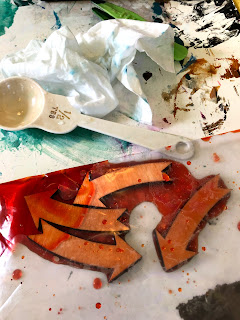We continued with our Songs, Verses & Movement for classroom routines.
Circle Time
#1 - "Good Morning, Dear Earth" verse
#2 - "Morning Verse"
from A Child's Seasonal Treasury, page 13
#3 - NEW - "Autumn Wind" verse
from Gesture Games for Autumn and Winter, p.53
#4 - NEW - "The Friendly Ghost" verse
from A Child's Seasonal Treasury, page 51
#5 - "Johnny Hammers with One Hammer" verse
from The Children's Music Studio, page 104
#6 - "I'm a Tall, Tall Tree" song
#7 - "Pull on My Rain Boots!" verse
from The Breathing Circle, page 88
#8 - "Old English Apple Picking" verse
from A Child's Seasonal Treasury, page 41
#9 - "Eat An Apple" finger play
#10 - "Five Little Pumpkins" finger play
#11 - NEW - "Three Little Witches" finger play
from A Child's Seasonal Treasury, page 49
#12 - NEW - "Halloween Song"
from Gesture Games for Autumn and Winter, p.68, CD track 26
Monday, October 28
- "The Old Owl on the Farm," p.58 from Tell Me a Story: Stories from the Waldorf Early Childhood Association of North America
- hollow out pumpkin
- sensory play with pumpkin "guts"
- mix an outdoor batch of Witch's Brew
The Witch's Brew activity was the definite hit of this morning! Lots of the older children wanted to do this too and joined right in. I didn't grab pencil and paper fast enough to catch all of the "ingredients," but I did my best. And, wow, the creativity was flying thick and fast. Who knew that a bright red autumn leaf was actually a salmander burp?
To the hollowed out pumpkin, they added water and...
- scales of lizard tongue
a salamander burp
the eye of the ancient frog
the touch of a goblin's toenail
vampire fang
ogre's eyes
broccoli Skittles
dragon's tear
silver flowers
ancient beehive
bark of a crystal tree
spider skin
the bow from a witch's hair
fairy powder
After all of the children had added things and stirred and stirred to their hearts' delight, we put in the two secret ingredients (a container of vinegar/water and a container of baking soda). It bubbled and fizzed in a most satisfactory way.
Tuesday, October 29
- "The Autumn Blanket," p.68 from Autumn: A Collection of Poems, Songs, and Stories for Young Children
- hammer coffee can lanterns for Lantern Walk
- Halloween Sensory Bin (canned pumpkin & cooked spaghetti)
- Mushy Green Pea Sensory Bin
- Georgie by Robert Bright
I didn't dye the cooked spaghetti black for our Halloween Sensory Bin; I simply used whole wheat spaghetti. Easier!
Also easy were our coffee can lanterns. Thank you, Ms. Shelby, for giving me a tip on these. Fill the coffee cans with water and leave them in the freezer overnight to freeze solid. It is much easier for the children to hammer through the metal walls of the coffee can without it bending while they are doing so. I used a finish hammer (lightweight) and a roofing nail (large head) and placed the coffee can on a towel while they were working on these one at a time. Add a few holes near the top for stringing the twine through. Set it out overnight for the water to thaw and, voila! A sturdy candle-ready lantern. "The Autumn Blanket" was the perfect gentle story to lead us into a discussion of the Lantern Walk and its celebration of light in the darkness.
The weather is starting to get colder so instead of spending a whole hour outside we came in early from recess and had a bonus story, Georgie.
Thursday, October 31
- "Winifred Witch and Her Golden Cat," p.61 from Tell Me a Story: Stories from the Waldorf Early Childhood Association of North America
- Simple Halloween Sensory Bin #1 (spider confetti & dyed orange rice)
- Simple Halloween Sensory Bin #2 (pumpkin confetti & black lentils)
- practice songs for Lantern Walk
Children who hadn't make lanterns did their hammering work today. Sensory bins once again reigned supreme. And, of course, we made Stone Soup!
Thank you to everyone who contributed to our Stone Soup. We had mushroom stock, shallots, carrots, broccoli, sweet potato, tomato, and zucchini. We also had Halloween cupcakes brought in by a family. Delicious!
Our community Lantern Walk (co-hosted by Trisha Revelle of Tinkergarten and myself) will be Sunday, November 3rd at 5 pm at Campus Lake Trail, with an optional Lantern Making Workshop beforehand at 4 pm at the DFC.
The songs we are learning for this special event are both from the book & CD The Singing Year by Candy Verney.
- "I Go With My Bright Little Lantern," track 73
"Glimmer, Lantern, Glimmer," track 74
Tinkergarten has pvoided a handout with words to the Martinmas Song (slightly revised) "I Go Outside With My Lantern" to their families as well. The sheet music and words for "Glimmer, Lantern, Glimmer" may also be found in Festivals Family and Food: Guide to Seasonal Celebration, p.107.
This post contains affiliate links to materials I truly use for homeschooling. Qualifying purchases provide me with revenue. Thank you for your support!















































 Immersive Experience
Immersive Experience Immersive Experience
Immersive Experience






